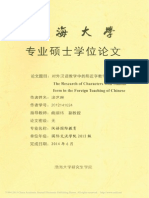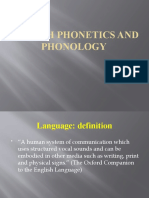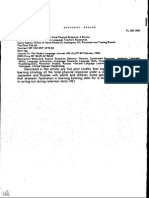Lesson Plan 1
Uploaded by
Crystal ZhaoLesson Plan 1
Uploaded by
Crystal ZhaoLESSON PLAN
Australian Curriculum Sequence and Year Level: Students’ Prior Knowledge:
Australian Curriculum Sequence:Second Language Learner 1. They understand the greetings: 你好,早上好,下午
Pathway Years 7-10 (Year 7 Entry) Sequence 好 and 晚上好
2. They understand how to introduce themselves using 我
Year Level: 7 - 8 叫.....,and several words 喜欢/不喜欢
3. They understand the four pitches, vowels and initials in
Pinyin
General Capabilities (that may potentially be covered in the lesson)
Literacy Numeracy ICT competence Critical and Ethical behaviour Personal and Social Intercultural
creative thinking competence understanding
Cross-curriculum priorities (may be addressed in the lesson)
Aboriginal and Torres Strait Islander histories and Asia and Australia’s engagement with Asia Sustainability
cultures
Content Descriptor(s):
Socialism:
- Exchange feelings, ideas and opinions, establish and maintain friendships and participate in group action
Systems of language:
- Recognise the tone-syllable nature of the spoken language, discriminate use of tones, rhythm, and sound flow in
interactions, and use Pinyin to support learning the spoken language
- Identify how character structure, position and component sequences relate the form of a character to its particular
sound and meaning
Achievement Standards:
1. They recognise the function of tone-syllables and Pinyin
2. They use gesture and some formulaic expressions to support oral interaction.
3. They apply 不 and 没有 in familiar phrases.
Learning Intentions:
As a result of this lesson, students will be able to:
• Recognise the basic syllabus in pinyin
• Write some common seen characters :人,日,月, 不
As a result of this lesson, students will know:
• The phonetic alphabet
• The use of 不 in the sentences they know
As a result of this lesson, students will understand:
• The patterns to pronounce the words with pinyin
Teacher Preparation and Resourcing:
PowerPoint (a big PowerPoint with several lessons content)
A picture table showing characters from oracle bone script to regular script with english meaning. (those characters are all looks
like a thing)
Matts paper (田字格)
Showing the order to write the characters and they will be ask to write the character five more times
The Chinese phonetic alphabet
Showing all the compounds including vowels and initials
Stephanie Andrews, University of Adelaide, 2018
LESSON DELIVERY (attach worksheets, examples, marking key, etc, as relevant)
Resources/References
Time Introduction:
Align these with the
3-5 mins Mark roll with Chinese greetings 你好,你好吗? segment where they will be
introduced.
5 mins Lesson Steps (Key content, structure, strategies, key interactions): White board:
- Writing the Chinese
Have a quick revision to the four pitches using a, name calling or volunteer to see
characters for countries
if everyone is on the same pace
and ask them to
Go through the plans for this lesson with students while writing on the side of the recognise it
board - Plans for the lesson
10 mins Class discussion if they searched some characters from last lesson’s homework. PowerPoint Slides
Presenting some characters that looks like a thing. Eg, 山,水,日 1. A picture table showing
characters from oracle
Introduce the five characters with pinyin on top of each and demonstrate the bone script to regular
writing in the white board. Explain the meaning of each character. We can use script with english
sentences from previous lesson. eg, 我不好,我不喜欢。 meaning. (those
characters are all looks
like a thing)
10 mins Introduce the matt paper and the Chinese phonetic alphabet and ask them to stick A matts paper showing the
the alphabet at the front of their note book. order to write the
Practice the five characters in the given matt paper with pinyin on top characters and they will be
ask to write the character
five more times
10 mins Work in group of 3-4, using the phonetic alphabet to figure out the sound of some The Chinese phonetic
given words using the five characters with pinyin on top. alphabet
Walk around for correction or teacher’s discussion on the alphabet to encourage - Use the one with
them guess the characters shown in the alphabet. pictures for each
component. Eg, i with
picture of clothes
5mins Lesson Closure:
Conclude the basic syllabus pattern after the group activity
Evaluation: (Exit card/success criteria)
Students will be asked to write what they’ve learnt within the three lessons and
hand up to me before they leave
Stephanie Andrews, University of Adelaide, 2018
You might also like
- Second Language Writing - Hyland - 2019 - Ch4 8.37.29No ratings yetSecond Language Writing - Hyland - 2019 - Ch4 8.37.2914 pages
- How To Use Anki With The Mandarin Blueprint MethodNo ratings yetHow To Use Anki With The Mandarin Blueprint Method76 pages
- Asian Languages Amp Literature - Integrated Chinese Level 1 Part 1 Teacher039s Handbook0% (1)Asian Languages Amp Literature - Integrated Chinese Level 1 Part 1 Teacher039s Handbook1 page
- Edexcel GCSE Chinese: Presenting Our Own Resources For The 2009 GCSE SpecificationNo ratings yetEdexcel GCSE Chinese: Presenting Our Own Resources For The 2009 GCSE Specification8 pages
- Six Principles For Teaching Foreign Language Vocabulary100% (1)Six Principles For Teaching Foreign Language Vocabulary4 pages
- ACTFL 21st Century World Languages Skills Map 2011100% (4)ACTFL 21st Century World Languages Skills Map 201121 pages
- Mandarin Excellence Programme: Teaching ResourcesNo ratings yetMandarin Excellence Programme: Teaching Resources14 pages
- 222 English Emotions Translated Into ChineseNo ratings yet222 English Emotions Translated Into Chinese11 pages
- World-Readiness Standards (General) + Language-specific document (CHINESE)From EverandWorld-Readiness Standards (General) + Language-specific document (CHINESE)No ratings yet
- Integrated Chinese Level 1 Part 1 Teacher ResourceNo ratings yetIntegrated Chinese Level 1 Part 1 Teacher Resource74 pages
- My Lesson Plan (Teach English Now! - Part 4) - Soleha Nur Azizah (Princess Chezzy)No ratings yetMy Lesson Plan (Teach English Now! - Part 4) - Soleha Nur Azizah (Princess Chezzy)2 pages
- Chinese - Yr 9 - Unit 1 - VELS Unit PlannerNo ratings yetChinese - Yr 9 - Unit 1 - VELS Unit Planner8 pages
- IC L3P1 Review Vocabulary - Text and ReportNo ratings yetIC L3P1 Review Vocabulary - Text and Report51 pages
- Asians" and "Westerners" - Examining The Perception of " (Non-) Native" Migrant Teachers of English in ThailandNo ratings yetAsians" and "Westerners" - Examining The Perception of " (Non-) Native" Migrant Teachers of English in Thailand13 pages
- Freeman, D. & Johnson, K.E. (1998) - Reconceptualizing The Knowledge-Base of Language Teacher100% (1)Freeman, D. & Johnson, K.E. (1998) - Reconceptualizing The Knowledge-Base of Language Teacher21 pages
- Shanghai Shanghai Shanghai Shanghai Jiao Jiao Jiao Jiao Tong Tong Tong Tong University University University UniversityNo ratings yetShanghai Shanghai Shanghai Shanghai Jiao Jiao Jiao Jiao Tong Tong Tong Tong University University University University52 pages
- Newsletter From Zhang Laoshi Chinese ClassroomNo ratings yetNewsletter From Zhang Laoshi Chinese Classroom2 pages
- Speed Up Your Chinese - Strategies To Avoid Common Errors (Speed Up Your Language Skills) - NodrmNo ratings yetSpeed Up Your Chinese - Strategies To Avoid Common Errors (Speed Up Your Language Skills) - Nodrm456 pages
- Mixed Research Methods A Research Paradigm Whose Time Has Come100% (1)Mixed Research Methods A Research Paradigm Whose Time Has Come3 pages
- Past Present and Future Tenses in Mandarin ChineseNo ratings yetPast Present and Future Tenses in Mandarin Chinese7 pages
- AI and Education The Importance of Teacher and Student RelationsNo ratings yetAI and Education The Importance of Teacher and Student Relations8 pages
- Summary On Teaching by Principles BrownNo ratings yetSummary On Teaching by Principles Brown49 pages
- TESOL Pre Interview Language Awareness Task 2016No ratings yetTESOL Pre Interview Language Awareness Task 20166 pages
- History of Philadelphia International AirportNo ratings yetHistory of Philadelphia International Airport3 pages
- Lexber Inc. V Sps. Dalman G.R. No. 183587, April 20, 2015No ratings yetLexber Inc. V Sps. Dalman G.R. No. 183587, April 20, 201514 pages
- En Collection of Data Sheets MPS PA 090804No ratings yetEn Collection of Data Sheets MPS PA 090804194 pages
- Chemistry Criterion D: Chemical Compounds in Daily Life 1No ratings yetChemistry Criterion D: Chemical Compounds in Daily Life 13 pages
- 03 11 2024 - SR - Super60 - NUCLEUS&STERLING BT - Jee Adv (2020 P2) - CTA 08&15 - Q.PaperNo ratings yet03 11 2024 - SR - Super60 - NUCLEUS&STERLING BT - Jee Adv (2020 P2) - CTA 08&15 - Q.Paper20 pages
- Bank Frauds and Role of RBI - Taxguru - inNo ratings yetBank Frauds and Role of RBI - Taxguru - in3 pages
- Configure ML-1660 For CUPS - Page 2 - UbuntuNo ratings yetConfigure ML-1660 For CUPS - Page 2 - Ubuntu4 pages
- Z@@Shenkar2022 Article TheLastFrontierOfGlobalizationNo ratings yetZ@@Shenkar2022 Article TheLastFrontierOfGlobalization13 pages
- Ramchandra Dwivedi Rachnavali - Edited by Surya Prakash Vyas100% (1)Ramchandra Dwivedi Rachnavali - Edited by Surya Prakash Vyas255 pages
- Write The Verbs in Brackets in The Correct FormNo ratings yetWrite The Verbs in Brackets in The Correct Form1 page
- PDF Instruction On Enabling Chinese Font and Typing CharactersNo ratings yetPDF Instruction On Enabling Chinese Font and Typing Characters18 pages
- Answer:: What Is "Pu" in Electrical Engineering?No ratings yetAnswer:: What Is "Pu" in Electrical Engineering?4 pages

























































































